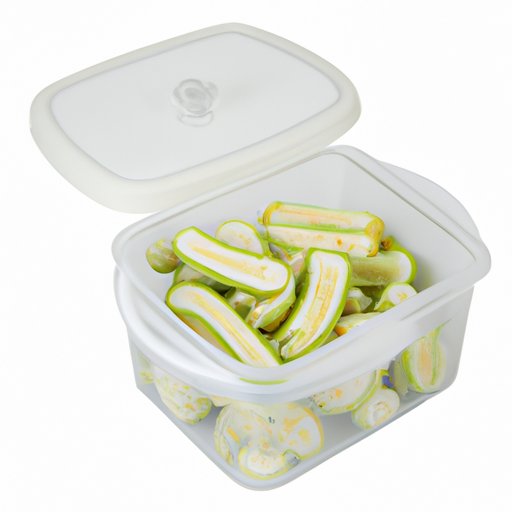
I. Introduction
Zucchini is a staple in many summer dishes, but it can be frustrating when it spoils quickly. The last thing you want is to waste food or have to make extra trips to the grocery store. Knowing how to properly store zucchini can extend its shelf life, save you time, and reduce food waste. In this article, we’ll explore different ways to store zucchini – both in the fridge and at room temperature – so you can enjoy this delicious vegetable for longer.
II. Tips on Storing Zucchini
The first step to storing zucchini properly is understanding the best practices. Here, we’ll go over the most effective ways to store zucchini and explain the benefits of each method:
1. Store Zucchini in the Refrigerator
The most common way to store zucchini is in the refrigerator. To do this, simply place the zucchini in a plastic bag and put it in the vegetable crisper section. Make sure you don’t wash the zucchini beforehand – this will add moisture and increase the chance of spoilage.
2. Wrap Zucchini in a Paper Towel
Before putting the zucchini in the plastic bag, wrap it in a paper towel. This will absorb any moisture and keep the zucchini dry. If you have excess zucchini that you don’t plan to use right away, you can also wrap it in a paper towel and put it in an airtight container before storing it in the fridge.
3. Use Zip-lock Bags to Store Zucchini
Instead of using a plastic bag, some people prefer to use a zip-lock bag to store zucchini. This helps to keep the zucchini dry and prevents it from drying out or getting freezer burn. Simply put the zucchini in the bag and squeeze out as much air as possible before sealing it.
4. Freeze Zucchini
If you have more zucchini than you can use before it spoils, freezing is a great option. Wash and cut the zucchini into bite-sized pieces, then blanch them in boiling water for 2-3 minutes. Immediately transfer the zucchini to an ice bath to stop the cooking process. Once the zucchini is cool, drain it and pat it dry with a paper towel. Place the zucchini in a freezer-safe container or bag and store it in the freezer for up to 8 months.
5. Store Zucchini in a Cool, Dry Place
If you don’t have enough fridge space or prefer not to store your zucchini in the fridge, you can store it in a cool, dry place. The ideal temperature for storing zucchini is between 50-60°F. A basement or pantry would be a good option – just make sure the area is dry and well-ventilated.
6. Use the Vegetable Crisper in Your Refrigerator
The vegetable crisper section in your refrigerator is specifically designed to keep produce fresh for longer. To get the most out of this feature, make sure the crisper is set to the right humidity level for storing vegetables. Leafy greens and vegetables that wilt easily should be stored in a high-humidity crisper, while firm vegetables like zucchini should be stored in a low-humidity crisper.
7. Use Airtight Containers
If you have excess zucchini or prefer to store it in containers instead of plastic bags, make sure the containers are airtight. This will prevent moisture from getting in and make sure the zucchini stays fresh. Glass containers are a good option because they don’t hold onto the odors of the zucchini like plastic containers can.
III. How to Store Zucchini Properly
Now that you know the different methods for storing zucchini, here’s a step-by-step guide on how to store it properly:
- If you plan to store the zucchini in the fridge, place it in a plastic bag or container and put it in the vegetable crisper.
- Before storing the zucchini, wrap it in a paper towel to absorb any moisture.
- If you prefer using zip-lock bags, squeeze out as much air as possible before sealing the bag.
- For freezing zucchini, blanch it in boiling water for 2-3 minutes, let it cool in an ice bath, and then pat it dry before storing it in a freezer-safe container or bag.
- If you’re storing zucchini in a cool, dry place, make sure the area is well-ventilated and the temperature is between 50-60°F.
- If you’re using the vegetable crisper, make sure it’s set to the right humidity level for storing firm vegetables like zucchini.
- If you’re using airtight containers, make sure they’re completely sealed to prevent moisture from getting in.
Regardless of the method you choose, always check the zucchini periodically to make sure it hasn’t spoiled. If you notice any mold, sliminess, or an off smell, it’s time to toss it out.
IV. Conclusion
Storing zucchini properly can save you time, money, and reduce food waste. By following these tips and methods, you can extend the shelf life of your zucchini and enjoy it for longer. Experiment with the different ways to store zucchini and find the one that works best for you. And remember, always check your zucchini regularly to ensure it hasn’t spoiled!
Want to learn more about food storage? Check out our other articles and resources on kitchen organization and food waste reduction.





